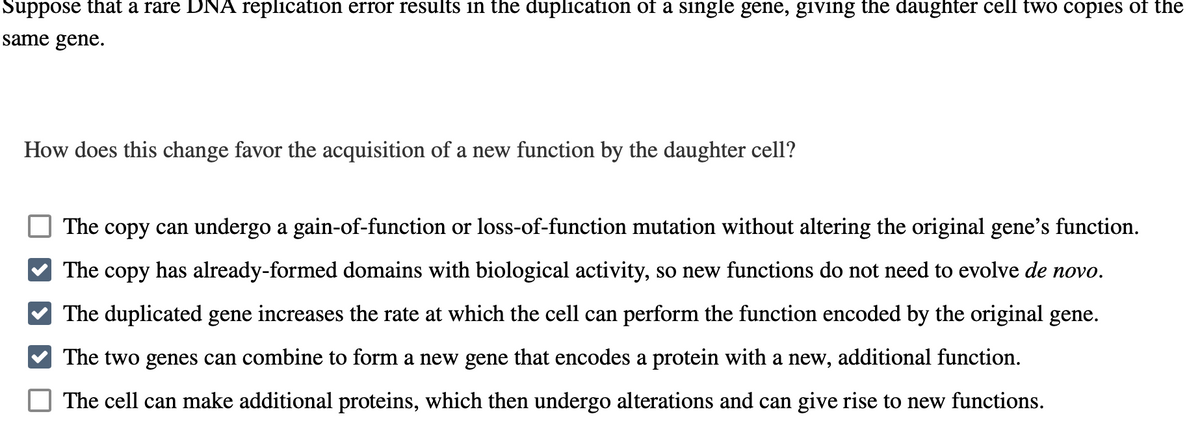Suppose that a rare DNA replication error results in the duplication of a single gene, giving the daughter cell two copies of t same gene. How does this change favor the acquisition of a new function by the daughter cell? The copy can undergo a gain-of-function or loss-of-function mutation without altering the original gene's function. The copy has already-formed domains with biological activity, so new functions do not need to evolve de novo. ✔ The duplicated gene increases the rate at which the cell can perform the function encoded by the original gene. The two genes can combine to form a new gene that encodes a protein with a new, additional function. The cell can make additional proteins, which then undergo alterations and can give rise to new functions.
Suppose that a rare DNA replication error results in the duplication of a single gene, giving the daughter cell two copies of t same gene. How does this change favor the acquisition of a new function by the daughter cell? The copy can undergo a gain-of-function or loss-of-function mutation without altering the original gene's function. The copy has already-formed domains with biological activity, so new functions do not need to evolve de novo. ✔ The duplicated gene increases the rate at which the cell can perform the function encoded by the original gene. The two genes can combine to form a new gene that encodes a protein with a new, additional function. The cell can make additional proteins, which then undergo alterations and can give rise to new functions.
Human Heredity: Principles and Issues (MindTap Course List)
11th Edition
ISBN:9781305251052
Author:Michael Cummings
Publisher:Michael Cummings
Chapter8: The Structure, Replication, And Chromosomal Organization Of Dna
Section: Chapter Questions
Problem 23QP: How does DNA replication occur in a precise manner to ensure that identical genetic information is...
Related questions
Concept explainers
Gene Interactions
When the expression of a single trait is influenced by two or more different non-allelic genes, it is termed as genetic interaction. According to Mendel's law of inheritance, each gene functions in its own way and does not depend on the function of another gene, i.e., a single gene controls each of seven characteristics considered, but the complex contribution of many different genes determine many traits of an organism.
Gene Expression
Gene expression is a process by which the instructions present in deoxyribonucleic acid (DNA) are converted into useful molecules such as proteins, and functional messenger ribonucleic (mRNA) molecules in the case of non-protein-coding genes.
Topic Video
Question

Transcribed Image Text:Suppose that a rare DNA replication error results in the duplication of a single gene, giving the daughter cell two copies of the
same gene.
How does this change favor the acquisition of a new function by the daughter cell?
The copy can undergo a gain-of-function or loss-of-function mutation without altering the original gene's function.
The copy has already-formed domains with biological activity, so new functions do not need to evolve de novo.
The duplicated gene increases the rate at which the cell can perform the function encoded by the original gene.
The two genes can combine to form a new gene that encodes a protein with a new, additional function.
The cell can make additional proteins, which then undergo alterations and can give rise to new functions.
Expert Solution
This question has been solved!
Explore an expertly crafted, step-by-step solution for a thorough understanding of key concepts.
Step by step
Solved in 3 steps

Knowledge Booster
Learn more about
Need a deep-dive on the concept behind this application? Look no further. Learn more about this topic, biology and related others by exploring similar questions and additional content below.Recommended textbooks for you

Human Heredity: Principles and Issues (MindTap Co…
Biology
ISBN:
9781305251052
Author:
Michael Cummings
Publisher:
Cengage Learning

Biology Today and Tomorrow without Physiology (Mi…
Biology
ISBN:
9781305117396
Author:
Cecie Starr, Christine Evers, Lisa Starr
Publisher:
Cengage Learning

Human Heredity: Principles and Issues (MindTap Co…
Biology
ISBN:
9781305251052
Author:
Michael Cummings
Publisher:
Cengage Learning

Biology Today and Tomorrow without Physiology (Mi…
Biology
ISBN:
9781305117396
Author:
Cecie Starr, Christine Evers, Lisa Starr
Publisher:
Cengage Learning